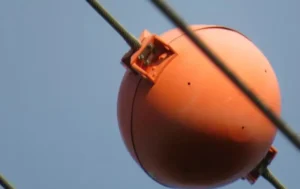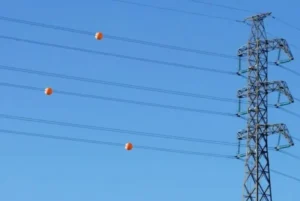Have you ever gazed up at the sky and noticed vibrant colored balls hanging from power lines? You might have wondered what purpose they serve or why they’re there. These fascinating markers are known as aerial marker balls, and they play a crucial role in ensuring the safety of both aircraft and the people on the ground. Let’s take a closer look at why these colorful balls are a common sight on power lines.
Guiding the Skies with Visibility Markers
The vibrant orbs you see dotting power lines are more than just decorations; they are powerful indicators that help keep our skies safe. These markers, often called visibility markers or aerial marker balls, serve a specific purpose: to alert low-flying aircraft to the presence of power lines. Think of them as miniature beacons guiding pilots away from potential hazards.
Staying Clear of Danger
Imagine a scenario where an aircraft is flying at a low altitude, possibly near canyons, lakes, rivers, or airports. In such situations, there’s a risk of the aircraft colliding with power lines that might not be immediately visible. To prevent this, the Federal Aviation Administration (FAA) mandates the use of these aerial marker balls on power lines that cross areas prone to low-flying aircraft traffic. By attaching these markers, we create a safer environment for both aviators and those of us on the ground.
Colors That Catch the Eye
Have you ever wondered why these marker balls come in different colors? The answer lies in maximizing visibility. The colors used—often orange, white, and yellow—are carefully chosen to stand out against various landscapes. When soaring through the sky, pilots need markers that are impossible to miss. These vibrant hues ensure that the markers catch their attention and alert them to the presence of power lines.

source: Wikimedia
The Remarkable Material: Plastic
You might be curious about what these marker balls are made of. Surprisingly, they are crafted from plastic. This choice of material is not only practical but also strategic. Plastic doesn’t conduct heat or electricity, which makes it an excellent electrical insulator. This property ensures that the marker balls don’t interfere with the power lines’ function while effectively enhancing safety.
From Size to Weight: The Technical Details
Marker balls come in various sizes, typically ranging from 20 to 36 inches in diameter. Despite their seemingly lightweight appearance, they weigh between 11 and 17 pounds. This balance between size and weight allows them to be easily attached to power lines while remaining sturdy and resistant to wind.
The Origin of Marker Balls
The story behind these colorful markers is as intriguing as their purpose. Nearly 50 years ago, in the early 1970s, an incident led to their creation. The then-governor of Arkansas, Winthrop Rockefeller, was aboard an airplane with Edward Holland, the head of the Arkansas Department of Aeronautics. As the plane descended, Rockefeller noticed electrical wires dangerously close to the aircraft.

source: Pixabay
Concerned about the safety of both pilots and passengers, Rockefeller urged Holland to find a solution to make power lines more visible to aviators. Holland, in turn, approached engineer Jack Rutledge to tackle this challenge. Rutledge’s ingenious solution involved designing bright and easily noticeable marker balls that could be attached to power lines without being easily displaced by wind.
Thanks to Rutledge’s innovation, these marker balls have become an integral part of aviation safety. By the 1980s, Rutledge’s company had risen to prominence as a leading supplier of visibility markers, contributing significantly to aviation safety worldwide. Countless lives have been saved over the decades because of the increased visibility these marker balls provide to pilots.
Next time you spot those colored balls hanging from power lines, remember that they aren’t just decorative additions. As technology continues to evolve, these marker balls remain a shining example of how a simple idea can have a profound impact on our world.